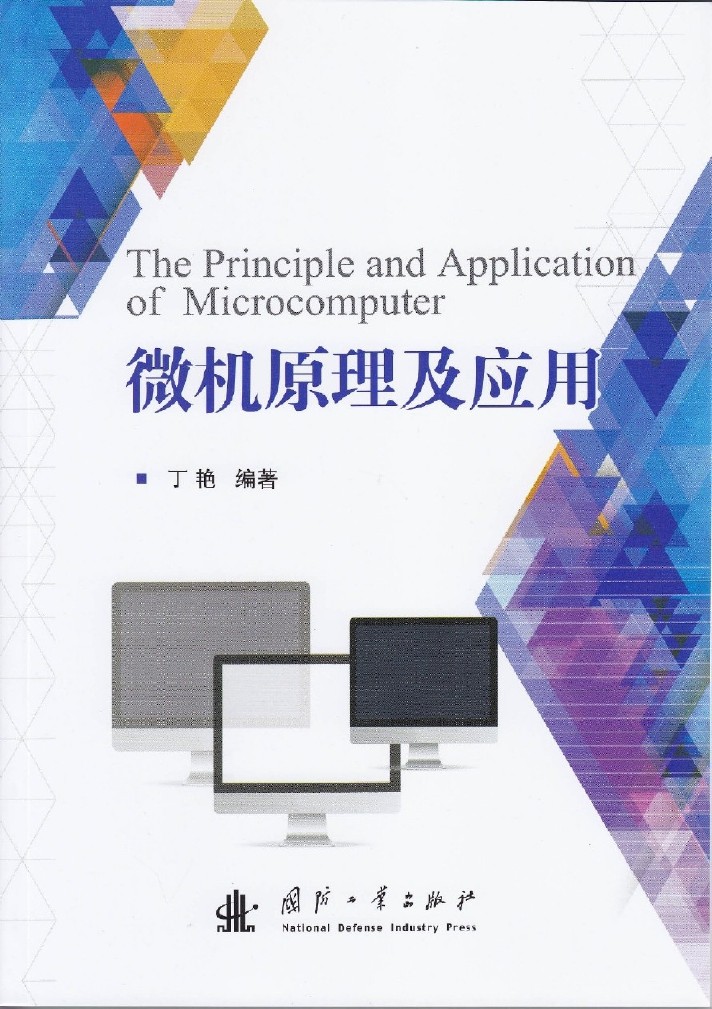《微機原理及套用(The Principle and Application of Microcomputer)》是2016年1月出版的圖書,作者是丁艷。
基本介紹
- 書名:微機原理及套用(The Principle and Application of Microcomputer)
- 作者:丁艷
- ISBN:978-7-118-10410-3
- 頁數:330
- 定價:58.00
- 出版時間:2016年1月
- 裝幀:平裝
- 開本:16
- 版次:1版1次
- 字數:490
- 中圖分類:TP36
內容簡介,編輯推薦,目錄,
內容簡介
本書以16 位微處理器為核心,全面講述了微型計算機的基本組成、工作原理以及硬體接口技術。全書共8 章,逐一講述了計算機基礎知識、微型計算機的基本組成及工作原理、16 位微處理器8086 / 8088CPU 的定址方式、指令系統、彙編程式的設計、輸入/輸出接口、存儲器系統和可程式定時/計數控制器等內容。本書是作者多年教學經驗的結晶,內容編排合理,由淺入深,體系完整,重點突出並配有豐富的例題及詳盡的注釋。
編輯推薦
本書採用全英文編寫,並配有部分漢語注釋,適合用作普通高等院校非計算機類各專業學生“微型計算機原理及套用”課程的教材,也可用作成人高等教育的培訓教材及廣大科技工作者的參考書。
目錄
Chapter 1Fundamentals of Computer1
1.1Number System1
1.1.1Basic Number Systems1
1.1.2Conversions between Different Number Systems 3
1.1.3Common Data Units7
1.2Logic Algebra and Logic Gates9
1.2.1“OR” Operation and “OR” Gate10
1.2.2“AND” Operation and “AND” Gate10
1.2.3“NOT” Operation and the NOT Inverter11
1.2.4Basic Rules of Boolean Algebra12
1.3Binary Numbers and Binary Addition/Subtraction13
1.3.1Negative Binary Numbers13
1.3.2Binary Addition14
1.3.3Binary Subtraction14
1.3.4Adder Circuits15
1.3.5Switchable Inverter and Binary Addition/Subtraction Circuit16
1.4Computer Data Formats17
1.4.1ACSII Code17
1.4.2BCD (Binary Coded Decimal) Format19
1.5Logic Circuit19
1.5.1Logic Gates19
1.5.2Flip Flops19
1.5.3Registers23
1.5.4Tri state Gate and BUS Structure25
Tips29
Exercise30
Chapter 2System Organization of
Microcomputer32
2.1The Basic System Components32
2.1.1CPU (Central Processing Unit)33
2.1.2The System Bus33
2.1.3The Memory Subsystem35
2.1.4The I/O Subsystem38
2.2A Simple Computer41
2.2.1Introduction 41
2.2.2Architecture of the Simple Computer 41
2.2.3Instruction Set of the Simple Computer45
2.2.4Encoding Instructions46
2.2.5Organization of the Control Unit47
2.2.6Step by Step Instruction Execution49
Tips51
Exercise 52
Chapter 3Intel 8086 Microprocessor54
3.1The History of Intel Microprocessor Family 54
3.28086 CPU Architecture59
3.2.1Execution Unit and Bus Interface Unit59
3.2.2Organization of Execution Unit61
3.2.3Organization of Bus Interface Unit (BIU)64
3.3Internal Memory66
3.3.1Addressing Data in Memory66
3.3.2Memory Segment67
3.3.3Segment Boundary68
3.3.4Segment Offset68
3.3.5About Stack Segment71
3.4System Timing72
3.4.1The System Clock72
3.4.2Memory Access Time73
3.4.3Wait States73
3.4.4Bus Cycle75
3.58086 Pin Assignments and Working Modes75
3.5.1Pins and Their Function Descriptions76
3.5.2Working Modes78
3.6Basic Operations of 8086/808888
3.6.1Reset Operation88
3.6.2Input and Output for 8086 Minimum Mode89
3.6.3Bus Request and Bus Grant Timing in Minimum Mode 91
3.6.4Interrupt Operation92
3.6.5Interrupt Operations in Maximum Mode97
Tips99
Exercise100
Chapter 48086 Address Mode and Assembly Instructions103
4.18086 Assembly Instruction Format103
4.28086 Addressing Modes104
4.2.1Immediate Addressing105
4.2.2Direct Addressing105
4.2.3Register Addressing106
4.2.4Register Indirect Addressing106
4.2.5Register Relative Addressing107
4.2.6Base plus Index Addressing108
4.2.7Base Relative plus Index Addressing 109
4.3Data Movement Instructions112
4.3.1MOV Instruction112
4.3.2PUSH and POP114
4.3.3XCHG Instruction115
4.3.4XLAT Instruction115
4.3.5LEA Instruction117
4.3.6LDS and LES118
4.3.7Flags Register Movement Instruction119
4.3.8IN and OUT120
4.4Arithmetic Instructions and Logic Instructions120
4.4.1ADD and SUB Function121
4.4.2INC and DEC Function124
4.4.3NEG and CMP Function124
4.4.4MUL and DIV Function126
4.4.5Type Conversion Functions127
4.4.6BCD Conversion Functions128
4.4.7Boolean Operations132
4.4.8Shifting and Rotation134
4.5String Instructions137
4.5.1The Direction Flag138
4.5.2String Data Transfers139
4.5.3String Comparisons140
4.6Program Control Instructions144
4.6.1Program Flow Control Instructions144
4.6.2Machine Control and Miscellaneous Instructions154
4.7The Symbolic Instruction Set 156
Tips158
Exercise159
Chapter 5Directives and Macro Processing163
5.1The Format of the Directives163
5.2Operators and Expression165
5.3Directives171
5.3.1Data Definition and Storage Allocation172
5.3.2EQU Directive174
5.3.3Segment Definition Directive175
5.3.4Assume Directive176
5.3.5PROC Directive 177
5.3.6END Directive178
5.3.7ORG Directive178
5.3.8Structures180
5.3.9Records182
5.3.10The PAGE and TITLE Listing Directives185
5.3.11EXTRN/EXTERN Directive185
5.3.12GROUP Directive185
5.3.13INCLUDE Directive186
5.3.14LABEL Directive186
5.4Macro Processing188
5.4.1Macro Definition188
5.4.2Macro Sequence and Procedure Calling191
5.4.3Macro Directives191
5.5DOS Function Calls193
5.5.1The IBM PC BIOS193
5.5.2An Introduction to MS DOS’ Services194
5.5.3MS DOS Calling Sequence195
5.5.4Frequently Used MS DOS Functions195
5.6Assembling, Linking and Executing a Program197
5.6.1The Assembler and Linker197
5.6.2Assembling a Source Program199
5.6.3Linking an Object Program199
5.6.4Executing a Program200
5.6.5Using the DEBUG Program200
5.6.6DEBUG Commands Exercise201
Tips204
Exercise205
Chapter 6Programming with Assembly Language207
6.1Design of Assembly Program207
6.2Simple Procedures Designing208
6.3Branch and Looping Procedures209
6.4Procedure Call and Return216
6.5Programming Examples220
Tips227
Exercise228
Chapter 7Memory System229
7.1Overview of the Memory229
7.1.1Non Volatile Memory230
7.1.2Volatile Memory232
7.1.3Performance Index of Memory System233
7.2Memory Devices235
7.2.1SRAM 6264235
7.2.2SRAM 6116240
7.2.3DRAM 2164A242
7.2.4EPROM 2764A243
7.3Memory Module Design245
7.3.1Memory Pin Connections245
7.3.2Memory Module Design247
7.3.3Memory Expansion Examples248
Tips251
Exercise251
Chapter 8I/O Interfaces253
8.1I/O Instructions254
8.2I/O Interfacing Methods256
8.3Serial Interface and Serial Communication257
8.3.1Serial Interface257
8.3.2Basic Serial Transmission Lines258
8.3.3Asynchronous and Synchronous Communication258
8.48251A Programmable Communication Interface261
8.4.1The Architecture of the 8251A261
8.4.2The Application of the 8251A266
8.4.3The Initialization of the 8251A271
8.5Parallel Communication Interface275
8.68255A Programmable Peripheral Interface276
8.6.1The Architecture of the 8255A276
8.6.2The Function Description of the 8255A280
8.6.3The Communication Mode of 8255A282
8.6.4The Initialization and Programming of 8255A288
8.7Programmable Timer and Event Counter289
8.8Intel’s 8253 Programmable Timer/Counter291
8.8.1The Architecture of 8253292
8.8.2The Operation Mode Definition of 8253296
8.8.3Examples of 8253 Timer/Counter302
Tips305
Exercise306
Appendix A8086/8088 Instruction Set Summary308
Appendix BVocabulary and Terms 322
Reference330"

